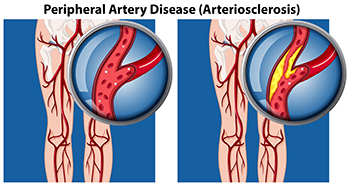The Two Types of Peripheral Artery Disease
Tuesday, 13 July 2021 00:00 Peripheral artery disease (PAD) is a condition in which blood flow to the lower limbs is reduced. This can cause symptoms such as leg cramping, pain, numbness, weakness, and difficulty walking. PAD can be described as being either occlusive or functional. Occlusive PAD means that something is physically blocking the blood flow in arteries. This is usually plaque, which builds up in the arteries and makes them narrow and harden over time, but arteries can also be blocked because of abnormal thickening of the artery walls. Functional PAD occurs when the arteries cease to function properly due to abnormal relaxation or constriction of the artery walls. If you are experiencing the symptoms of PAD, it is suggested that you see a podiatrist who can help you manage this condition.
Peripheral artery disease (PAD) is a condition in which blood flow to the lower limbs is reduced. This can cause symptoms such as leg cramping, pain, numbness, weakness, and difficulty walking. PAD can be described as being either occlusive or functional. Occlusive PAD means that something is physically blocking the blood flow in arteries. This is usually plaque, which builds up in the arteries and makes them narrow and harden over time, but arteries can also be blocked because of abnormal thickening of the artery walls. Functional PAD occurs when the arteries cease to function properly due to abnormal relaxation or constriction of the artery walls. If you are experiencing the symptoms of PAD, it is suggested that you see a podiatrist who can help you manage this condition.
Peripheral artery disease can pose a serious risk to your health. It can increase the risk of stroke and heart attack. If you have symptoms of peripheral artery disease, consult with Dawn Miles, DPM from Florida. Our doctor will assess your condition and provide you with quality foot and ankle treatment.
Peripheral artery disease (PAD) is when arteries are constricted due to plaque (fatty deposits) build-up. This results in less blood flow to the legs and other extremities. The main cause of PAD is atherosclerosis, in which plaque builds up in the arteries.
Symptoms
Symptoms of PAD include:
- Claudication (leg pain from walking)
- Numbness in legs
- Decrease in growth of leg hair and toenails
- Paleness of the skin
- Erectile dysfunction
- Sores and wounds on legs and feet that won’t heal
- Coldness in one leg
It is important to note that a majority of individuals never show any symptoms of PAD.
Diagnosis
While PAD occurs in the legs and arteries, Podiatrists can diagnose PAD. Podiatrists utilize a test called an ankle-brachial index (ABI). An ABI test compares blood pressure in your arm to you ankle to see if any abnormality occurs. Ultrasound and imaging devices may also be used.
Treatment
Fortunately, lifestyle changes such as maintaining a healthy diet, exercising, managing cholesterol and blood sugar levels, and quitting smoking, can all treat PAD. Medications that prevent clots from occurring can be prescribed. Finally, in some cases, surgery may be recommended.
If you have any questions, please feel free to contact one of our offices located in Palatka and Saint Augustine, FL . We offer the newest diagnostic and treatment technologies for all your foot care needs.









